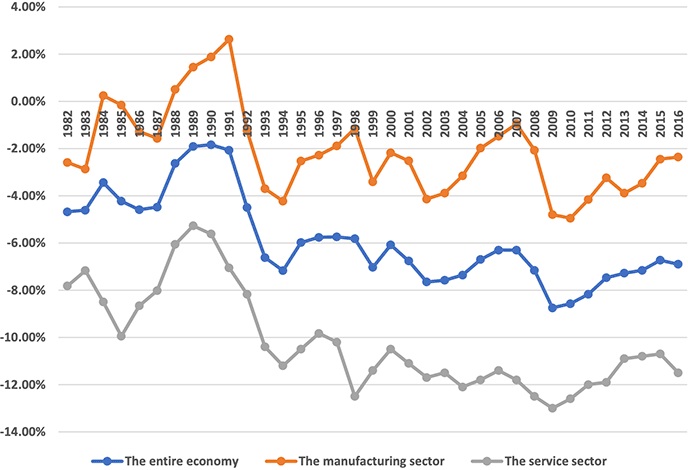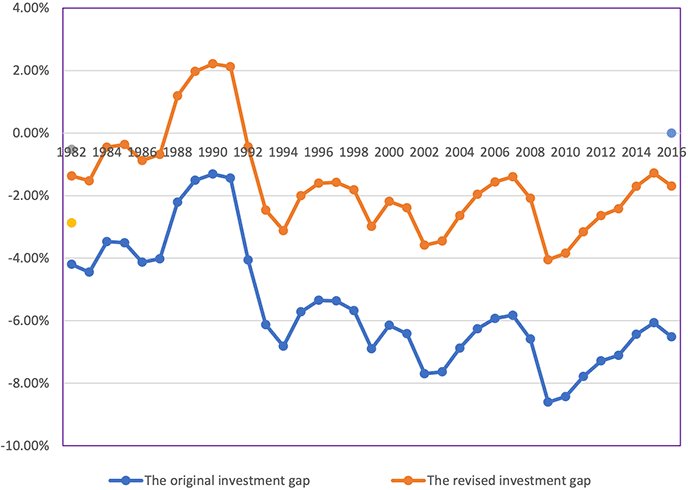The Japanese economy has seen a decline in the contribution of capital accumulation to economic growth since 2000. This column uses over 30 years of national productivity data to explore this trend. It finds that the fall in tangible capital accumulation has largely been offset by investment into intangible capital. However, the growth in tangible and intangible capital accumulation has been imbalanced, calling for support of both types of asset accumulation.
Growth accounting using the 2021 version of the Japanese Industrial Productivity database tells us that the contribution of capital accumulation to economic growth in Japan has declined since 2000. Table 1 shows that the contribution of capital services to economic growth is dominant and accounted for 73% of the total economic growth in the latter half of the 1990s. Although the share of the contribution of capital services did not change in the 2000s, its contribution declined from 0.98% in the latter half of the 1990s to 0.22% in the 2000s. In the 2010s, its contribution further declined and its share of total economic growth fell to 15%, because the economic growth rate in the 2010s was higher than that in the 2000s. As the growth rates in labour input and the total factor productivity growth rebounded in the 2010s, the low rate of capital input accumulation is the main cause of the stagnation of the Japanese economy.

[Click to enlarge]
In the US, the secular stagnation after the collapse of the IT bubble led to many discussions on the topic. Among them, Gutierrez and Philippon(2017)and Crouzet and Eberly (2018) pointed out that one reason for this secular stagnation was the declining capital formation. Our study examines whether their arguments are also able to explain the declining capital formation in Japan.
The analytical framework developed by Gutierrez and Philippon(2017)and Crouzet and Eberly (2018) is Tobin's q theory with two assets: tangibles and intangibles. According to the standard theory assuming a single asset, capital formation is explained by Tobin's q, which is measured by dividing the firm value by the resale value of the capital stock. However, when capital assets consist of observable tangibles and intangibles that are not captured in the financial statements, the simple relationship between capital formation in observable tangibles and Tobin's q does not hold. While observable capital formation covers only tangible assets, firm valuation on the stock market is likely to reflect the value of not only tangibles but also intangibles.
Following their arguments based on multiple Tobin's q theory, we examine whether the declining capital formation in tangibles is replaced by the increasing investment in intangibles (Miyagawa and Ishikawa 2021). Our study shows that capital formation in intangibles explains three fourths of the investment gap between capital formation estimated by multiple Tobin's q theory and real tangible investment.
Gutierrez and Philippon(2017)and Crouzet and Eberly (2018) measured the gap between the potential capital formation explained by Tobin's q and the actual capital formation that consists of only observable tangible assets. In addition, Crouzet and Eberly (2018) showed that capital formation in intangibles explains two thirds of this gap.
Following their studies, we measure the investment gap in Japan. We obtain the industry-level capital formation data from the Japanese System of National Accounts (SNA). As Tobin's q is the discounted value of future profits, we measure the industry-level Tobin's q in the steady state by dividing the gross profit rate by the user cost of capital.
When we regress capital formation in tangibles on Tobin's q with time dummies, the estimated series of time dummies show the investment gap shown in Figure 1. We find that the investment gap in Japan has widened since the collapse of the bubble economy, and it is over 6% in the 2010s. This implies that the capital formation in tangibles in Japan has been less than the amount of capital formation indicated by Tobin's q. When we observe this investment gap by sector, we find that the gap in the service sector is larger than that in the manufacturing sector. While the investment gap in the manufacturing sector has fluctuated between 0% and 4% since the collapse of the bubble economy, the service sector has maintained larger gaps.

To find the factors that explain the changes in the investment gap, we regress the variable with the ratio of intangibles to tangibles and foreign direct investment. Although we are not able to obtain firm-level data of intangible investments, we obtain the data of intangible assets such as R&D and software from the Japanese SNA. Foreign direct investment is similar to intangible investment because capital formation, which is mainly captured in the statistics, focuses on domestic accumulation in tangible assets.
Estimation results show that the increase in intangible investment is associated with the large investment gap in a statistically significant manner. However, foreign direct investment is not related to movements of the investment gap. Using these results, we examine how much the changes in intangibles explain the investment gap. Figure 2 shows that three fourths of the investment gap are explained by the changes in intangibles. When we consider accumulation in intangibles, this gap decreases from 6.5 % to 1.7% in 2016. The role of intangibles in the investment gap in Japan is larger than that in the US, shown by Crouzet and Eberly (2018).

We find that the increase in intangibles fills the investment gap due to the decline of capital formation in tangible assets in Japan. From the viewpoint of the aggregate demand side, this substitutable role of intangibles has prevented total capital formation from declining. However, from the viewpoint of productivity improvement, the changes in intangibles should be associated with those in tangibles, because the complementary role in intangibles contributes to productivity growth.
Early in the COVID-19 pandemic, we were shocked that we were not able to capture the correct number of COVID-19 cases due to a lack of digital equipment and of skilled workers who are able to use this equipment in Japan. This tells us that the unbalanced growth in tangibles and intangibles will slow total economic growth, because the complementary effect of intangibles on tangibles is insufficient to compensate. We recommend that the government supports the growth in capital formation of both types of assets.
Editor's note: The main research on which this column is based (Miyagawa and Ishikawa 2021) first appeared as a Discussion Paper of the Research Institute of Economy, Trade and Industry (RIETI) of Japan.
This article first appeared on www.VoxEU.org on August 27, 2021. Reproduced with permission.



